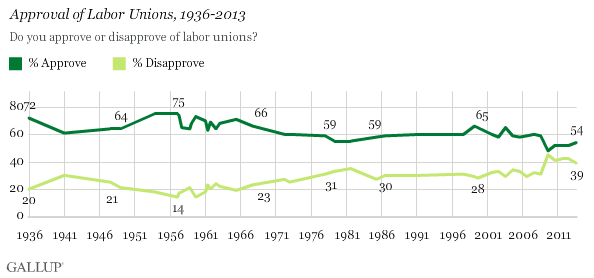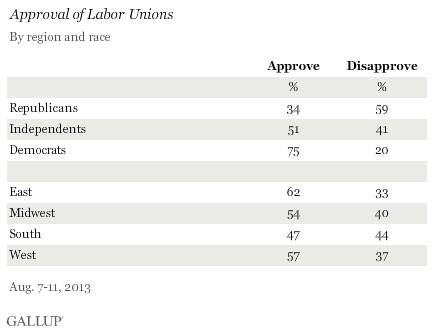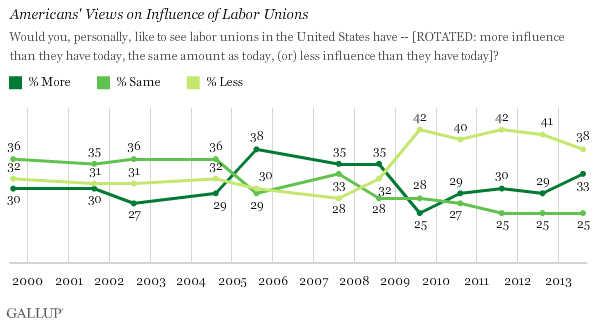WASHINGTON, D.C. -- Heading into Labor Day weekend, a majority of Americans, 54%, approve of labor unions, a slight increase from 52% in 2012 and six percentage points above the all-time low observed in 2009. Thirty-nine percent disapprove of labor unions.

The current reading is eight points below the historical average of 62% in Gallup's trend dating back to 1936.
Americans' approval of labor unions has declined precipitously since Gallup first asked this question, when 72% said they approved. Labor union approval reached an all-time high of 75% in 1953 and 1957, remained above 60% through the end of the 1960s, and then dipped a bit during the 1970s, 1980s, 1990s, and most of the 2000s. Approval fell to an all-time low of 48% in 2009, the first year of the Obama administration. This drop may have been a backlash against a Democratic administration that some feared would overly empower labor unions. Since then, labor union approval has remained at bare majority levels.
Union approval is a classic partisan issue. Relatively few Republicans (34%) approve of labor organizations, while three-quarters of Democrats (75%) do. Americans living in the South, the region with the least labor union presence, are less likely to approve of labor unions (47%) than are those living in other regions.

Prevalence of Household Union Membership Stagnant Since 2003
Nineteen percent of respondents report that either they or another household member belongs to a labor union, with 8% saying they personally belong, 9% saying another household member belongs, and 2% saying they and at least one other household member belong.
The percentage of households in which a union member lives has shown little fluctuation in the Gallup trend since 2003, ranging from 16% to 19%. This percentage was slightly lower in 2002, at 14%.

Americans' Outlook for Unions Bleak
Given that fewer than one in five households have a labor union member, it is perhaps not surprising that 52% of Americans believe labor unions will become weaker in the future. Twenty-one percent believe unions will stay the same in terms of influence, and 22% believe they will become stronger.
More Americans have said labor unions will grow weaker than stronger in the future since the question was first asked in 1999, and a majority has consistently said so since 2011.

At the same time, Americans are divided on whether labor unions should have more influence or less influence. Thirty-eight percent would prefer that they have less influence, while a nearly equivalent 33% would instead like them to have more. An additional 25% say labor unions should have the same amount of influence that they have today.

Implications
Labor unions were a crucial part of the movement to create the popular Labor Day holiday, but their image among the public has struggled in the past few years. More ominous for unions and their supporters is that over half of Americans say unions will become weaker in the future. Successful efforts to weaken union power, such as recent passage of "right to work" legislation in Michigan and Indiana, may be contributing to this sense that unions are in decline.
Survey Methods
Results for this Gallup poll are based on telephone interviews conducted Aug. 7-11, 2013, with a random sample of 2,059 adults, aged 18 and older, living in all 50 U.S. states and the District of Columbia.
For results based on the total sample of national adults, one can say with 95% confidence that the margin of sampling error is ±3 percentage points.
Interviews are conducted with respondents on landline telephones and cellular phones, with interviews conducted in Spanish for respondents who are primarily Spanish-speaking. Each sample of national adults includes a minimum quota of 50% cellphone respondents and 50% landline respondents, with additional minimum quotas by region. Landline and cell telephone numbers are selected using random-digit-dial methods. Landline respondents are chosen at random within each household on the basis of which member had the most recent birthday.
Samples are weighted to correct for unequal selection probability, nonresponse, and double coverage of landline and cell users in the two sampling frames. They are also weighted to match the national demographics of gender, age, race, Hispanic ethnicity, education, region, population density, and phone status (cellphone only/landline only/both, and cellphone mostly). Demographic weighting targets are based on the March 2012 Current Population Survey figures for the aged 18 and older U.S. population. Phone status targets are based on the July-December 2011 National Health Interview Survey. Population density targets are based on the 2010 census. All reported margins of sampling error include the computed design effects for weighting.
In addition to sampling error, question wording and practical difficulties in conducting surveys can introduce error or bias into the findings of public opinion polls.
View methodology, full question results, and trend data.
For more details on Gallup's polling methodology, visit www.gallup.com.
